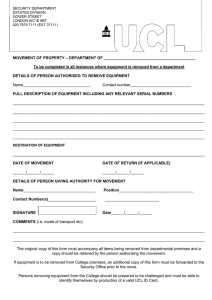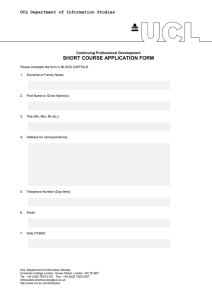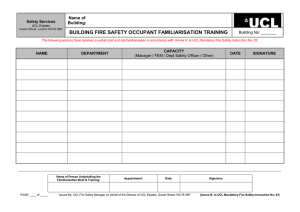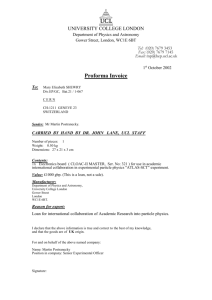FLAMMABLE LIQUID & SOLVENT - DSEAR BULK STORAGE DESIGN GUIDE CONTENTS
advertisement
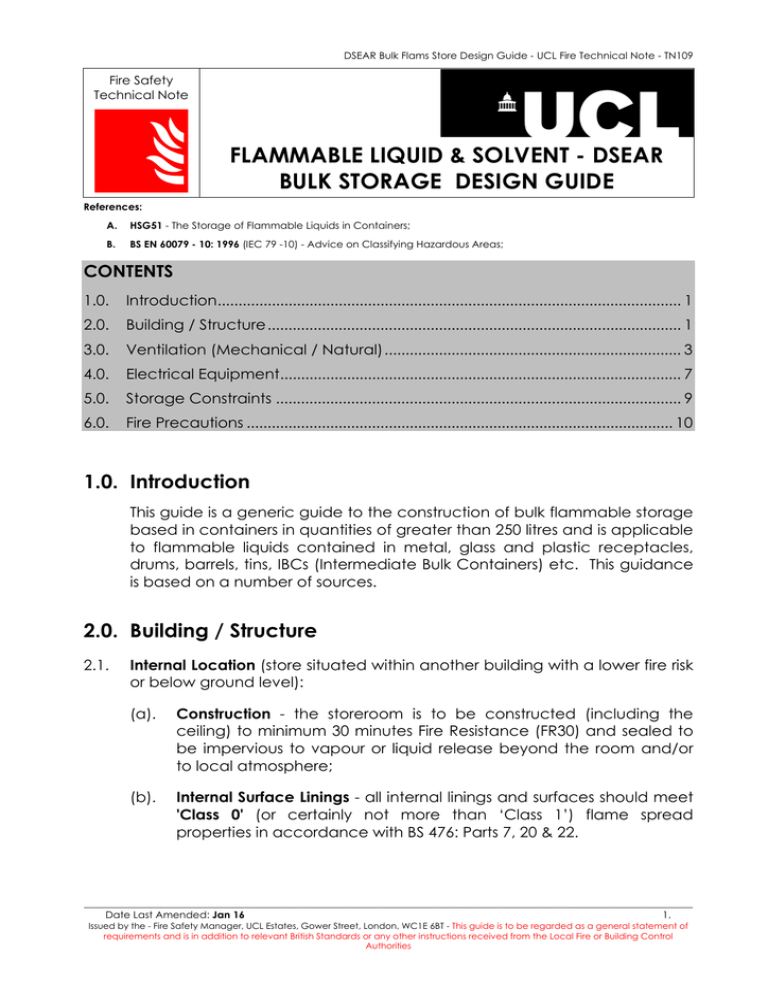
DSEAR Bulk Flams Store Design Guide - UCL Fire Technical Note - TN109 Fire Safety Technical Note FLAMMABLE LIQUID & SOLVENT - DSEAR BULK STORAGE DESIGN GUIDE References: A. HSG51 - The Storage of Flammable Liquids in Containers; B. BS EN 60079 - 10: 1996 (IEC 79 -10) - Advice on Classifying Hazardous Areas; CONTENTS 1.0. Introduction............................................................................................................... 1 2.0. Building / Structure ................................................................................................... 1 3.0. Ventilation (Mechanical / Natural) ....................................................................... 3 4.0. Electrical Equipment................................................................................................ 7 5.0. Storage Constraints ................................................................................................. 9 6.0. Fire Precautions ...................................................................................................... 10 1.0. Introduction This guide is a generic guide to the construction of bulk flammable storage based in containers in quantities of greater than 250 litres and is applicable to flammable liquids contained in metal, glass and plastic receptacles, drums, barrels, tins, IBCs (Intermediate Bulk Containers) etc. This guidance is based on a number of sources. 2.0. Building / Structure 2.1. Internal Location (store situated within another building with a lower fire risk or below ground level): (a). Construction - the storeroom is to be constructed (including the ceiling) to minimum 30 minutes Fire Resistance (FR30) and sealed to be impervious to vapour or liquid release beyond the room and/or to local atmosphere; (b). Internal Surface Linings - all internal linings and surfaces should meet 'Class 0' (or certainly not more than ‘Class 1’) flame spread properties in accordance with BS 476: Parts 7, 20 & 22. ______________________________________________________________________________________________________________________ Date Last Amended: Jan 16 1. Issued by the - Fire Safety Manager, UCL Estates, Gower Street, London, WC1E 6BT - This guide is to be regarded as a general statement of requirements and is in addition to relevant British Standards or any other instructions received from the Local Fire or Building Control Authorities DSEAR Bulk Flams Store Design Guide - UCL Fire Technical Note - TN109 (c). 2.2. (i). Personnel escape distances shall not exceed 18m in two directions and 9m in 1 direction; (ii). Subject to the selected design, storerooms may require additional escape doors leading directly to open air; (iii). Pallet Access - in order to rotate a standard pallet, a minimum aisle width of 2m is required (pallet dimensions are approx. 1 x 1.25m). Pallet storage requirements are most efficiently catered for using a 4.5 or 9m wide room dimension. The 4.5m wide room module uses a centre aisle with pallets either side, whilst the 9 m wide room has pallets at the sides, with provision for back to back pallets in the centre; (iv). Internal and external doors shall provide safe and efficient access and egress, and shall be of suitable size and construction. Fire doors, which are not in everyday use, must be clearly signed and fitted with appropriate emergency escape furniture; External to Another Building Location (store is situated & accessed on an external wall of the building): (a). 2.3. Fire / Escape / Access Door(s) - the store is to be fitted with fire resisting door to meet a minimum of FD30(S)SC in construction. In some locations and circumstances there may need to be FD60(S)SC fire doors and/or a fire lobby introduced. To be agreed as part of the review with UCL Fire Safety Manager: the location will determine construction, control measures and therefore the issue should be discussed with the UCL Fire Safety Manager; additional guidance is also provided at Reference A as listed above; External Location (store is situated in an open area and not attached to another building): (a). the location will determine construction, control measures and therefore the issue should be discussed with the UCL Fire Safety Manager; additional guidance is also provided at Reference A. (b). A steel portal frame building is the most suitable solution, as it offers flexibility of use with column free floor plans and construction plan advantages. The design shall incorporate a lightweight roof to act as an explosion relief conduit. All internal and external walls shall be fire rated to a minimum of 1-hour duration; ______________________________________________________________________________________________________________________ Date Last Amended: Jan 16 2. Issued by the - Fire Safety Manager, UCL Estates, Gower Street, London, WC1E 6BT - This guide is to be regarded as a general statement of requirements and is in addition to relevant British Standards or any other instructions received from the Local Fire or Building Control Authorities DSEAR Bulk Flams Store Design Guide - UCL Fire Technical Note - TN109 2.4. Containment (Internal & External) - flammable liquids are to be stored in suitable containers; any spillage should be contained and prevented from spreading to other parts of the storage area or external ground. A means of controlling spillage is the use of an impervious sill or low bund, or, as an alternative, a drain from the area to a safe place, such as a remote sump or a fuel / liquid separator: (a). Sills are to be provided to contain any leaks or releases from containers within the store: (i). Construction may be by sloping the floor away from the door; (ii). Constructing a sill across the door(s) openings: o The size of the sill needs to provide containment of 110% of the capacity of the largest container(s) stored, based on a multi breakage or leak event; o Typically, such sills are about between 75 mm to 150 mm high in height but should be based on the capacity of the room and largest container or damaged containers; (b). Ramps may be required over the sill to allow access for wheeled trolleys etc., and will require suitable gradients bund ramps should have a maximum slope of 1 in 15; Floor Linings - the floor lining is made from an impervious material, which is not effected by the contents or the materials stored within the room, should they come into direct contact. The lining should extend up the walls to be adequate to meet the total volume of potential spillage, plus 10%; 3.0. Ventilation (Mechanical / Natural) To prevent dangerous concentrations of flammable vapours building up in a store or storage area as the result of a leak or daily operations, the space needs to be adequately ventilated. Good ventilation is essential to ensure that any vapours given off from a spill, leak, or release will be rapidly dispersed. Mechanical Ventilation: 3.1. Mechanical Ventilation of Internal Locations - where the provision of natural ventilation is not possible due to stores being located centrally within a building or at basement level or within a room with limited access to external walls (only one or two outside walls or in sheltered locations), then adequate mechanical ventilation is to be provided: ______________________________________________________________________________________________________________________ Date Last Amended: Jan 16 3. Issued by the - Fire Safety Manager, UCL Estates, Gower Street, London, WC1E 6BT - This guide is to be regarded as a general statement of requirements and is in addition to relevant British Standards or any other instructions received from the Local Fire or Building Control Authorities DSEAR Bulk Flams Store Design Guide - UCL Fire Technical Note - TN109 (a). Mechanical ventilation provided is to comply with Reference A & B. The ventilation arrangements should take into account the heavy nature of the vapours and to ensure adequate air movement at both high and low levels; 3.2. Electric Motors - obviously, electric motors situated in the path of the vapour being extracted in ventilation ducting may ignite flammable vapours and may become dangerous if coated with flammable residues. Such residues may cause overheating of the motor and the residues themselves may undergo spontaneous combustion. Motors inside ductwork are also difficult to maintain. The Highly Flammable Liquids and Liquefied Petroleum Gases Regulations 1972 prohibit the positioning of electric motors (including explosion-protected motors) in ductwork containing flammable vapours. 3.3. Bifurcated, Axial or Centrifugal Type Fans (with motors located outside of hazardous vapour stream) - should be the standard type of motor considered at an early stage design. Fans made from non-sparking materials provide an additional precaution against friction spark. 3.4. Air Changes - centrifugal or bifurcated fans will be required to provide a minimum of five air changes per hour or sufficient to ensure vapour levels in the store are kept to a low level. Note - a Mechanical Engineer may be required to review increasing the number of air changes per hour, dependent on the materials and activities within the store. (a). 3.5. These fans will need to operate constantly - failure of an extraction system is a significant hazard and needs to be detected by an airflow-monitoring device. These devices’ are usually installed in the ductwork (such as a flow switch or differential pressure switch) and linked to an alarm that raises the alarm at a suitable point via Building Energy Management (BEM) system or other suitable platform; Ducting - the exhausted air needs to be routed to a safe place in the open air, via fire-resisting ductwork to meet at least 30 minutes Fire Resistance (FR30) and be of a construction impervious to the release of vapour: (a). Ducts should be arranged so that vapours cannot condense and collect at low points within the ductwork. In most cases, it should be adequate for the ventilation ductwork to be terminated: (i). at least 3 metres above ground level; (ii). at least 3 metres from building openings, boundaries, sources of ignition; and, (iii). away from building eaves and other obstructions; ______________________________________________________________________________________________________________________ Date Last Amended: Jan 16 4. Issued by the - Fire Safety Manager, UCL Estates, Gower Street, London, WC1E 6BT - This guide is to be regarded as a general statement of requirements and is in addition to relevant British Standards or any other instructions received from the Local Fire or Building Control Authorities DSEAR Bulk Flams Store Design Guide - UCL Fire Technical Note - TN109 (iv). (b). depending on location, ducts may need to be fitted with a flame arresting device; Ducting - ducts, trunking and casings should be such that if tested in accordance with BS 476: Parts 20 & 22 they would be capable of satisfying the integrity requirement of that test for at least 30 minutes (FR30). (i). ducts to be provided with internal surfaces to the enclosure to meet ‘Class 0’ surface spread of flame and heat release; (ii). ducts should be supported and fastened in such a manner, using supports and fastenings that are of high melting point (in excess of 750°C), that: o the structure plus its supports, if tested in accordance with BS 476: Parts 20 and 22, would not collapse or come apart for at least 30 minutes; o the joints are made, bonded or fire-stopped to prevent or retard the passage of flame and hot gases; o the structure is sufficiently robust that its integrity will not be impaired by any reasonably foreseeable accidental impact; o and, should be sufficiently durable that, if coated with residues, these can be removed without impairing the structure’s fire resistance; (iii). The internal low-level vents are to be positioned just above the bund / sill level; (iv). Internal vents design must prevent obstructions by the storage of materials or the positioning of the storage racking; (v). Ducts will be required to achieve cross flow ventilation where a storeroom does not have two external walls - more than one duct may be needed. Where such ducts pass through fire rated walls they must have fire dampers with a rating coincident with the wall; (vi). Make up air intakes for mechanical ventilation shall be arranged to take air from non-hazardous areas and met the same fire specification in terms of construction and dampers and other safety features; ______________________________________________________________________________________________________________________ Date Last Amended: Jan 16 5. Issued by the - Fire Safety Manager, UCL Estates, Gower Street, London, WC1E 6BT - This guide is to be regarded as a general statement of requirements and is in addition to relevant British Standards or any other instructions received from the Local Fire or Building Control Authorities DSEAR Bulk Flams Store Design Guide - UCL Fire Technical Note - TN109 3.6. 3.7. Heating - occasionally, storage buildings or internal stores containing flammable liquids are heated. In this case, the heating system should not be an ignition source. This can be achieved by ensuring that only indirect heating means are used. For example, you could have radiators, fed remotely by hot water pipes, or indirectly fired gas or oil appliances (i.e. those that take the air for combustion from safe areas and exhaust the products of combustion to the outside air). Electrically heated radiators complying with Reference B may be used. Product degradation can occur due to condensation therefore background heating, controlled by local thermostats (intrinsically E× safe) may be required in some storerooms. To minimise the heating requirement it is first necessary to check the temperature range at which the products can be stored; Systems utilising wall-mounted radiators need to maintain minimum distances between the radiators installed and be fitted with protective guards to ensure no substances can be placed against them; High-level radiant or under floor heating systems do not impose the restrictions described above; Hot Surfaces - in all cases the heating system needs to be protected against the build-up of flammable residues on hot surfaces. The maximum temperature of any exposed heating surfaces should not exceed the autoignition temperature of any of the flammable liquids in storage. Guidance on this issue is contained in Reference B, above. Natural Ventilation: 3.8. For small buildings, the simplest method of ensuring adequate ventilation is to provide fixed, permanent openings (such as air bricks or louvers etc.) at high and low levels in external walls to the outside air. The five air changes per hour may be achieved if these openings have a total area equivalent to 1 to 3% of the total area of the walls and roof of the store. The actual area required depends on whether the building is in exposed or sheltered weather conditions. BS5925:1991 gives advice on ventilation principles and designing for natural ventilation in buildings. Buildings containing LPG are to have openings not less than 2.5% of the combined area of the walls and roof of the room or 12% of the area of one of the external walls, whichever is the greater. It is essential that low and high natural ventilation to the open air be provided. Forced ventilation is prohibited; ______________________________________________________________________________________________________________________ Date Last Amended: Jan 16 6. Issued by the - Fire Safety Manager, UCL Estates, Gower Street, London, WC1E 6BT - This guide is to be regarded as a general statement of requirements and is in addition to relevant British Standards or any other instructions received from the Local Fire or Building Control Authorities DSEAR Bulk Flams Store Design Guide - UCL Fire Technical Note - TN109 3.9. If openings are present on two walls, a cross-flow induced by wind forces is encouraged. Vents provided at high and low level would encourage air circulation by thermal currents. Ventilation openings in internal walls are not to be positioned on or below the level of any containment sill provided. These openings should not be obstructed on either side by, for example, container stacks, dirt or rubbish. 3.10. Ventilation openings should not normally be installed in any partitions designed to be fire resisting. Where this is unavoidable, such openings will be required to self-close in a fire situation to provide suitable fire separation. 3.11. Flame Arresting Gauze and Pest Control - all natural openings both high and low level should be fitted with stainless steel gauze with 16 to 20 perforations per linear inch, to act as a flame arrestor and to stop the ingress of insects and vermin. The gauze should be considered in any calculations of the 1 to 3% of the total area of the walls to achieve the five air changes per hour by these openings. 4.0. Electrical Equipment For UCL purposes, all locations will be treated as Zone 2 Classification unless activities or materials determine a higher electrical zone level. Electrical Zones are classified as follows under Reference B: 4.1. Zone 0 - the store has an explosive gas-air mixture continuously present, or present for long periods; Zone 1 - the store has an explosive gas-air mixture, which is likely to occur in normal operations; Zone 2 - the store has an explosive gas-air mixture, which not likely to occur during normal operations. If it does occur, it will exist only for a short time such as an accidental spillage; Mechanical Ventilation - mechanical ventilation provided must comply with the relevant Electrical Zone requirements of Reference B, in construction and installation. 4.2. Ventilation - mechanical ventilation fan(s) provided to have Explosion Proof (E×) / Intrinsically Safe enclosures. The fan(s) are to be generally Bifurcated, Axial or Centrifugal types (with motors located outside of the hazardous vapour stream) and the fan(s) are to discharge at least 3m away from any other openings; Electrical Equipment - all fixed electrical equipment with in the hazardous zone areas including general lighting, emergency lighting (where fitted) and any switching equipment has Electrical Explosion Proof (E×) and / or Intrinsically Safe enclosures, fittings and connections provided: ______________________________________________________________________________________________________________________ Date Last Amended: Jan 16 7. Issued by the - Fire Safety Manager, UCL Estates, Gower Street, London, WC1E 6BT - This guide is to be regarded as a general statement of requirements and is in addition to relevant British Standards or any other instructions received from the Local Fire or Building Control Authorities DSEAR Bulk Flams Store Design Guide - UCL Fire Technical Note - TN109 Ignition sources - reduction measures: o electrical lighting, power circuits and equipment which are not suitably protected against igniting a flammable vapour, e.g. not flameproof or intrinsically safe - must not be used; o hot surfaces; o static electricity build up; o all internal lighting shall be enclosed to meet to (E×) Zone 2; o There should be NO electrical sockets (or immediate outside of the store room) as a means of introducing None Intrinsically Safe electrical apparatus into the flammable store; o Where necessary electrical switchgear shall be housed in an external enclosure; 4.3. 4.4. Lighting: All electrical light switching (and test facilities) on the external wall to the room or positioned outside of the electrical zone and be provided with an indicating LED light to warn that the lighting is switched on; Emergency lighting shall be to the requirements of BS 5266-1 (High Risk) to give a luminance of approximately 15 lux. The luminaires shall be of the non-maintained self-contained type with 3 hours duration; External lighting shall be considered to allow normal operations to be undertaken safely during the hours of darkness; Fire Alarm: Internal Stores - a fire alarm Manual Call Point (MCP), weather proofed (WP) if necessary, should be provided outside of the store but within a short distance to raise the alarm, if required; Automatic Fire Detection (AFD) will depend on contents and the need to provide early detection. Smoke or Flame detectors may need to be considered, but must be intrinsically safe (E×) and be reviewed as required in discussion with the UCL Fire Safety Manager; Detection if provided, needs to be appropriate to the products of combustion that may arise from the materials being stored and commensurate with the risk; External Stores - a fire alarm system and AFD may not be required, depending on circumstances and risk; ______________________________________________________________________________________________________________________ Date Last Amended: Jan 16 8. Issued by the - Fire Safety Manager, UCL Estates, Gower Street, London, WC1E 6BT - This guide is to be regarded as a general statement of requirements and is in addition to relevant British Standards or any other instructions received from the Local Fire or Building Control Authorities DSEAR Bulk Flams Store Design Guide - UCL Fire Technical Note - TN109 4.5. Lightening: External / standalone storage buildings should be provided with suitable lightening protection system; BS EN62305 series has specific guidance on lightening protection systems; 5.0. Storage Constraints 5.1. 5.2. 5.3. Storage Racking: Stack height not to exceed 2m; Consideration should be given to racking being secured to all walls to prevent topple; Storage racking is not to obstruct ventilation grills; Storage racking should be constructed to withstand chemical and corrosive materials and weight being stored on the racks; Store Floor and Contents Loading (Guide): Generally the Floor space loading = 300 litres per m2 of net usable space; The net usable floor area = xxx m2; The bund depth = xxx mm; Total bund capacity = xxx m3 or xxx litres; Bund capacity = xxx litres + 10% = xxx Litres; The maximum capacity of the largest single container kept in the store = xxx Litres; The maximum store contents capacity (in containers holding less than xxx litres) = xxx Litres; Emergency Spill Kit - emergency spill equipment should be available close to hand, with suitable absorbent material for the substances contained within the store. ______________________________________________________________________________________________________________________ Date Last Amended: Jan 16 9. Issued by the - Fire Safety Manager, UCL Estates, Gower Street, London, WC1E 6BT - This guide is to be regarded as a general statement of requirements and is in addition to relevant British Standards or any other instructions received from the Local Fire or Building Control Authorities DSEAR Bulk Flams Store Design Guide - UCL Fire Technical Note - TN109 6.0. Fire Precautions 6.1. Flammable Information Signs - a Highly Flammable / No Smoking / Naked Flames (or similar) sign is to be provided externally to the store. 6.2. Other measures: No Smoking permitted with 3m of store; No Naked Lights permitted with 3m of store; No Electrical Equipment (other than (E×) to be used in the store; Waste to be removed and kept clear; 6.3. Fire Action Notice(s) – notices to be provided giving information on ‘action on discovering fire’ and ‘on hearing the fire alarm’ and any specific emergency procedures necessary. 6.4. Fire Extinguishers - a suitable fire extinguisher type to be located in close proximity to the store but not located within the store (as per UCL Fire Extinguisher Policy TN023). Subject to recommendations contained within the COSHH data sheets of the materials within the stores. ______________________________________________________________________________________________________________________ Date Last Amended: Jan 16 10. Issued by the - Fire Safety Manager, UCL Estates, Gower Street, London, WC1E 6BT - This guide is to be regarded as a general statement of requirements and is in addition to relevant British Standards or any other instructions received from the Local Fire or Building Control Authorities DSEAR Bulk Flams Store Design Guide - UCL Fire Technical Note - TN109 General Principals (acknowl edgement to HSG51) General Storage Principals (acknowl edgement to HSG51) _____________________________________________________________________________________________________________________________________________________________________________________ Date Last Amended: Jan 16 11. Issued by the - Fire Safety Manager, UCL Estates, Gower Street, London, WC1E 6BT - This guide is to be regarded as a general statement of requirements and is in addition to relevant British Standards or any other instructions received from the Local Fire or Building Control Authorities DSEAR Bulk Flams Store Design Guide - UCL Fire Technical Note - TN109 _____________________________________________________________________________________________________________________________________________________________________________________ Date Last Amended: Jan 16 12. Issued by the - Fire Safety Manager, UCL Estates, Gower Street, London, WC1E 6BT - This guide is to be regarded as a general statement of requirements and is in addition to relevant British Standards or any other instructions received from the Local Fire or Building Control Authorities DSEAR Bulk Flams Store Design Guide - UCL Fire Technical Note - TN109 Ventilation (acknowledgement to HSG51) _____________________________________________________________________________________________________________________________________________________________________________________ Date Last Amended: Jan 16 13. Issued by the - Fire Safety Manager, UCL Estates, Gower Street, London, WC1E 6BT - This guide is to be regarded as a general statement of requirements and is in addition to relevant British Standards or any other instructions received from the Local Fire or Building Control Authorities
